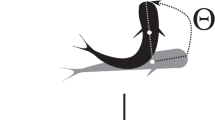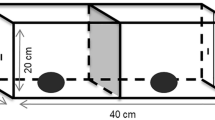Abstract
Octopus vulgaris is able to open transparent glass jars closed with plastic plugs and containing live crabs. The decrease in performance times for removing the plug and seizing the prey with increasing experience of the task has been taken to indicate learning. However, octopuses’ attack behaviors are typically slow and variable in novel environmental situations. In this study the role of preexposure to selected features of the problem-solving context was investigated. Although octopuses failed to benefit from greater familiarity with the training context or with selected elements of the task of solving the jar problem, the methodological strategies used are instructive in potentially clarifying the role of complex problem-solving behaviors in this species including stimulus preexposure and social learning.
Similar content being viewed by others
References
Agnisola C, Castaldo P, Fiorito G (1996) Octopus vulgaris (Mollusca, Cephalopoda) as a model in behavioral pharmacology: a test of handling effects. Physiol Behav 59:729–733
Aldenderfer MS, Blashfield RK (1984) Cluster analysis. Sage, Beverley Hills
Allen A, Michels J, Young JZ (1986) Possible interactions between visual and tactile memories in Octopus. Mar Behav Physiol 12:81–97
Angermeier WF, Dassler K (1992) Inhibitory learning and memory in the lesser octopus (Eledone cirrhosa) Bull Psychonom Soc 30:309–310
Biederman GB, Davey VA (1993) Social learning in invertebrates. Sci 259:1627–1628
Boletsky SV, Hanlon RT (1983) A review of the laboratory maintenance, rearing and culture of cephalopod mollusks. Mem Natl Mus Victoria 44:147–187
Boyle PR (1986) Neural control of cephalopod behavior. In: Willows AOD (ed) The Mollusca, vol 9. Neurobiology and behavior, part 2. Academic Press, Orlando, pp 1–100
Fiorito G, Scotto P (1992) Observational learning in Octopus vulgaris. Science 256:545–547
Fiorito G, Planta C von, Scotto P (1990) Problem solving ability of Octopus vulgaris Lamarck (Mollusca, Cephalopoda) Behav Neurol Biol 53: 217–230
Forsythe JW, Hanlon RT (1994) A comparison of foraging tactics used by Sepioteutis sepioidea and Octopus cyanea on tropical coral reefs. Paper presented at conference “The behavior and natural history of cephalopods”, CIAC, Vico Equense, June
Forsythe JW, Hanlon RT (1997) Foraging and associated behavior by Octopus cyanea Gray, 1849 on a coral atoll, French Polynesia. J Exp Mar Biol Ecol 209:15–31
Lubow RE (1973) Latent inhibition. Psychol Bull 79:398–407
Lubow RE, Rifkin B, Alek M (1976) The context effect: the relationship between stimulus pre-exposure and environmental pre-exposure determines subsequent learning. J Exp Psychol Anim Behav Proc 2:38–47
Maldonado H (1963) The positive learning process in Octopus vulgaris. Z Vergl Physiol 47:191–214
Maldonado H (1964) The control of attack by Octopus. Z Vergl Physiol 47:656–674
Mather JA (1980) Some aspects of food intake in Octopus jubini Robson. Veliger 22:286–290
Moriyama T, Gunji YP (1997) Autonomous learning in maze solution by Octopus. Ethology 103:499–513
Pack JE (1979) Octopus: apparatus and procedures for laboratory housing and for research on visual wavelength discrimination. MA thesis, Austin State University, Austin, Texas
Papini MR, Bitterman ME (1991) Appetitive conditioning in Octopus cyanea. J Comp Psychol 105:107–114
Sanders GD (1975) The Cephalopods. In: Corning WC, Dyal JD, Willows AOD (eds) Invertebrate learning, vol 3. Cephalopods and echinoderms. Plenum, New York, pp 1–136
Siegel S, Castellan NJ (1988) Nonparametric statistics for the behavioral sciences, 2nd edn. McGraw-Hill, New York
Winer BJ (1971) Statistical principles in experimental design, 2nd edn. McGraw-Hill, New York
Wishart D (1987) Clustan, cluster analysis software (computer program). Clustan, Edinburgh
Yarnall JL (1969) Aspects of the behavior of Octopus cyanea Gray. Anim Behav 17:747–754
Young JZ (1956) Visual responses by Octopus to crabs and other figures before and after training. J Exp Biol 33:709–729
Young JZ (1971) The anatomy of the nervous system of Octopus vulgaris. Clarendon, Oxford
Young JZ (1983) The distributed tactile memory system of Octopus. Proc R Soc Lond 218:135–176
Young JZ (1991) Computation in the learning system of cephalopods. Biol Bull 180:200–208
Author information
Authors and Affiliations
Electronic supplementary material
An Octopus vulgaris opening a jar (MPEG-Movie 11.60 MB)
Rights and permissions
About this article
Cite this article
Fiorito, G., Biederman, G., Davey, V. et al. The role of stimulus preexposure in problem solving by Octopus vulgaris . Anim Cogn 1, 107–112 (1998). https://doi.org/10.1007/s100710050015
Received:
Revised:
Published:
Issue Date:
DOI: https://doi.org/10.1007/s100710050015




